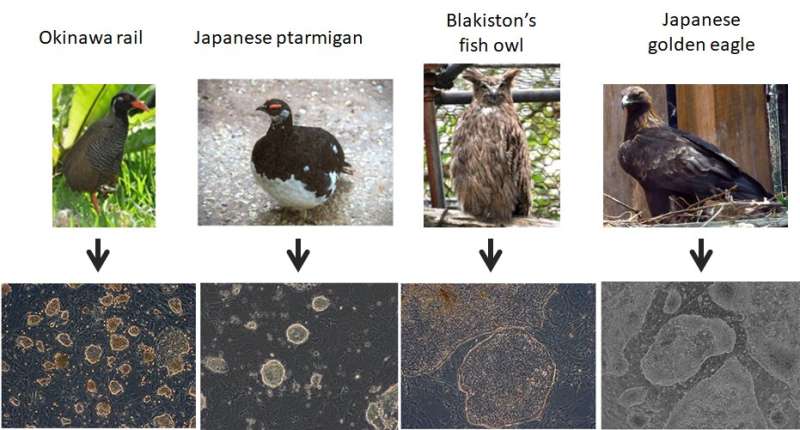The upper panel images show the endangered avian species and lower images are of iPSCs from the corresponding avian species. Credit: National Institute for Environmental Studies
Japan extends from north to south, resulting in a huge diversity of climate and environmental conditions. Various endemic species have evolved in Japan as a result of their ability to adapt to diverse environmental conditions. Thus, Japan is a hotspot of animal diversity with a number of endemic species that are already, or are becoming, endangered. With the numbers increasing steadily in recent years, mainly due to human activities such as forest destruction and global warming, action must be taken.
According to data from the Ministry of the Environment, Government of Japan, 1,446 species are categorized as endangered (red-list categories Critically Endangered (CR), Endangered (EN), and Vulnerable (VU)). Notably, 98 avian species are categorized as endangered, including 24 critically endangered, 31 endangered, and 43 vulnerable species. Conservation of endangered species is essential for maintaining biological diversity, especially for the future generations.
Application of new technologies, such as induced pluripotent stem cells (iPSCs), may help salvage the decreasing numbers of endangered animals and conservation of genetic resources. iPSCs express pluripotency markers through pluripotency-related genes, and differentiate into three germ layers in vivo and in vitro. We established novel iPSCs from three endangered avian species (Okinawa rail, Japanese ptarmigan, and Blakiston's fish owl), using seven reprogramming factors (M3O, Sox2, Klf4, c-Myc, Nanog, Lin 28, and Klf2).
iPSCs from these three endangered avian species displayed different cellular characteristics even though the same reprogramming factors were used. Japanese ptarmigan-derived iPSCs have biological characteristics different from those observed in other avian-derived iPSCs. Japanese ptarmigan iPSCs contribute to chimera formation in chick embryos. To the best of our knowledge, this is the first study to establish iPSCs from primary fibroblasts of the three endangered avian species.
Our findings provide the first evidence of the potential value of iPSCs as a resource for conservation of endangered avian species. In addition to these three species, we also established Japanese golden eagle-derived iPSCs. All the four iPSCs derived from the endangered avian species can differentiate into various cells, such as neural-like cells and hepatocyte-like cells. These differentiated cells can be used to evaluate the risk of infectious diseases and pollution by these avian species. The convincing outcomes of our study indicate that the established iPSCs can contribute to conservation of these as well as other endangered avian species.
The research is published in the October 24, 2022 issue of Communications Biology.
More information: Masafumi Katayama et al, Induced pluripotent stem cells of endangered avian species, Communications Biology (2022). DOI: 10.1038/s42003-022-03964-y
Journal information: Communications Biology
Provided by National Institute for Environmental Studies























